
HartRAO Home >
news >
Cryogenic 22 GHz receiver on 26m Telescope 2014-05-05
Cryogenic 22 GHz receiver on 26m Telescope 2014-05-05
During 1998 to 2005 a new main reflecting surface was installed on the
HartRAO 26m
telescope, with the objectives of improving performance at high frequencies
and increasing the usable upper frequency limit
from 12 GHz to the 22 GHz band. An uncooled test 22 GHz receiver was
installed in 2007 to test performance in that band after the upgrade. This provided a system
temperature of over 200 K, so it was not particularly sensitive. However it
demonstrated that the upgraded antenna did provide useful performance at 22
GHz. Use of the telescope for VLBI at 22 GHz with the test receiver has
grown, and requests for 22 GHz continue to increase. The orbiting Russian radio
telescope Radioastron operates in this band, and since December 2013 HartRAO
has been doing frequent VLBIs with Radioastron and other radio telescopes on
the ground, including at 22 GHz.
Another new request was for 22 GHz astrometric VLBI to help improve the
International Celestial Reference Frame (ICRF), which uses thousands of
distant quasars as fixed sources as its basis. A decision was therefore
taken late in 2013 to develop a more sensitive cryogenic 22 GHz receiver, with the target of
having it working on the telescope for the 24-hour 22 GHz astrometric VLBI
scheduled for 4-5 May 2014.
The feed horn and waveguide components for the receiver are sufficiently
small that they could be included inside the cryogenic vacuum package and
cooled down with the low noise amplifiers. This resulted in a very low
receiver noise temperature of 20 - 25 K. The contribution of the dry winter
atmosphere at zenith roughly matches this. The sensitivity near zenith is
about five times better than the uncooled test receiver. This degrades away
from zenith as the noise contribution from the atmospheric water vapour
increases and the paraboloid dish surface deforms under asymmetric
gravitational loading.
The receiver was installed on the 26m telescope on 23 April 2014, and
operated successfully in the astrometric VLBI on 4 - 5 May.
Astronomer Aletha de Witt is leading the astrometry research at
HartRAO, and commented:
"K-band (22 GHz) radio observations have the potential to form the basis for
the most accurate Celestial Reference Frame (CRF) ever constructed. K-band
CRF observations currently exist only from the all-northern Very Long
Baseline Array (VLBA) and therefore must be complemented by observations
from southern arrays in order to realise this potential. A collaboration has
been formed with the goal of completing sky coverage at K-band with specific
emphasis on the Southern hemisphere where K-band CRF coverage is weak.
Preliminary astrometric observations were carried out on 23 August 2013
between telescopes in Australia (Hobart 26m telescope), Korea (Tamna 21m) and South
Africa (HartRAO 26m). More extensive astrometric observations were carried
out on 21 December 2013 that also included the Tidbinbilla 70m NASA Deep
Space Network (DSN) antenna in Australia."
"We identified the uncooled K-band receiver on the HartRAO 26m antenna
as one of the major error sources in our K-band CRF work and thus made it
high priority to develop a cooled receiver. Our first CRF observations with
the new HartRAO receiver ran for 24 hours starting on 4 May 2014 between the
Hobart 26m, Tidbinbilla 70m and the HartRAO 26m telescopes."
The pictures below show stages in the development of the receiver and VLBI
fringe test results.
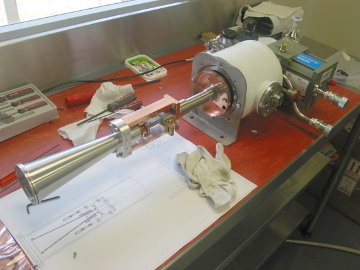
Left click on image for large version. Credit: M Gaylard / HartRAO
2014 Jan 10 - The feed horn is seen at left with polariser and waveguide
attached to the cooling head
of the refrigerator in the centre, and with the helium-gas expander on the right.
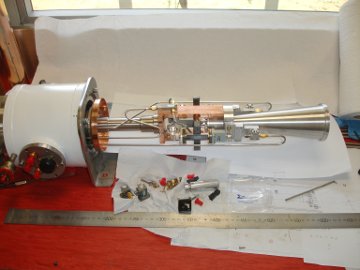
Left click on image for large version. Credit: M Gaylard / HartRAO
2014 Feb 26 - The low-noise amplifiers have been added, together with semi-rigid cabling.
The ruler provides the scale.
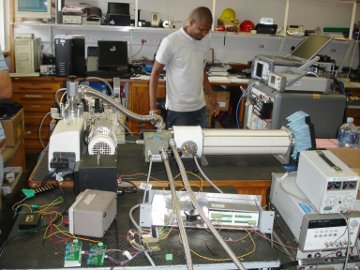
Left click on image for large version. Credit: M Gaylard / HartRAO
2014 March 22 - The feed horn and waveguide are now enclosed in the white tubular vacuum
jacket and the receiver has been cooled down for the first time. Microwave
engineer Ronnie Myataza was responsible for the RF section of the receiver.
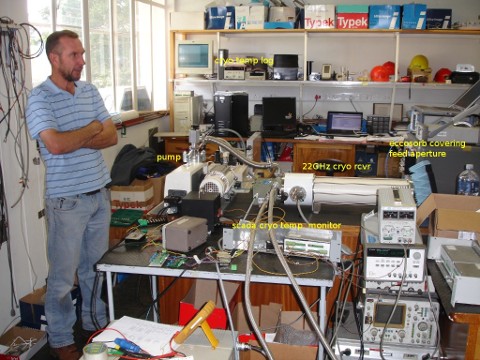
Left click on image for large version. Credit: M Gaylard / HartRAO
2014 March 22 - Pieter Stronkhorst was responsible for the cryogenic
packaging of the receiver, whose main components are identified.
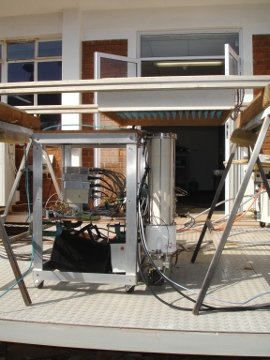
Left click on image for large version. Credit: M Gaylard / HartRAO
2014 April 11 - The receiver in the outdoor test facility, to measure its noise temperature.
Blue pyramidal microwave absorber is mounted over the feed aperture to provide a "hot" load for the
calibration. The sky provides a cold load when the microwave absorber is removed.
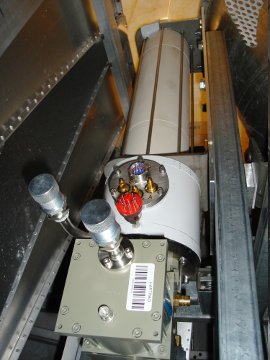
Left click on image for large version. Credit: P Stronkhorst / HartRAO
2014 April 23 - The receiver has just been installed on the axis of the 26m
telescope, at the secondary focus inside the Cassegrain cone. The helium lines for the
refrigerator and the various cables have yet to be added. The dual feed
horns of the 6 cm / 5 GHz receiver can be seen on the left.
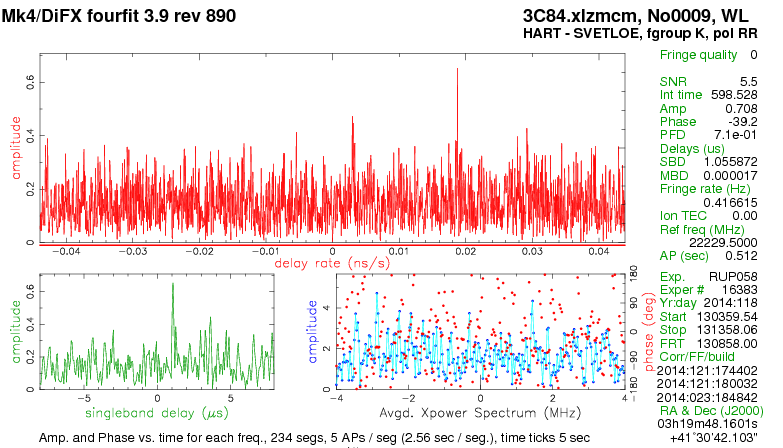
Credit: A Melnikov / Kvasar Network
2014 April 28 - Oops! In the first VLBI fringe test, with the radio
telescopes of the Russian Kvasar network, there is no interference fringe with the
same signal polarization between HartRAO and the Svetloe telescope. The top
plot just shows random noise. What has gone wrong?
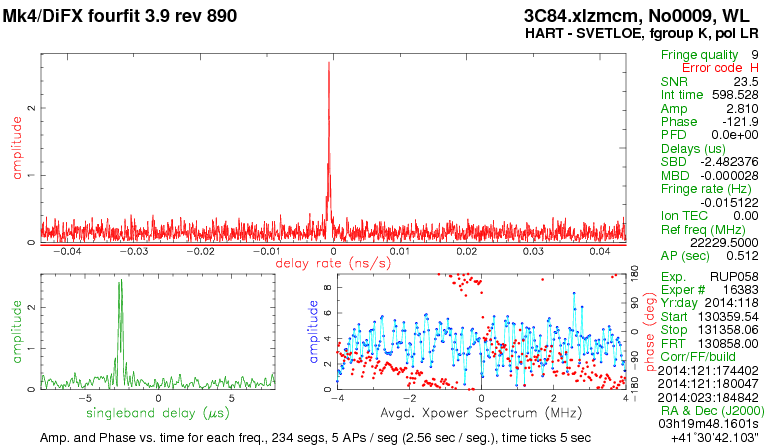
Credit: A Melnikov / Kvasar Network
2014 April 28 - Aah! When oppositely polarised signals are tested,
the interference fringe appears - the large spike in the centre of the top
plot. Fixing this is a simple matter of swapping the two output cables from
the receiver. The detection of the fringes otherwise indicates that the
receivers on both telescopes are locked in frequency to
the hydrogen maser atomic clocks at each telescope and are phase stable.
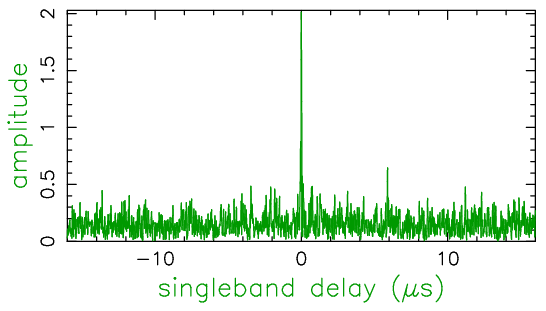
Credit: Alessandra Bertarini
IGG / Max Planck Institut fur Radioastronomie
2014 May 04 - VLBI interference fringes were successfully detected in a short test
at the start of the astrometric VLBI between
the 26m telescopes at HartRAO and Hobart, Tasmania. Here the fringes are
with the same sense of signal polarization at both telescopes, showing the
swapped polarization problem had been fixed. The radio source was the
bright Active Galactic Nucleus J1427-4206.
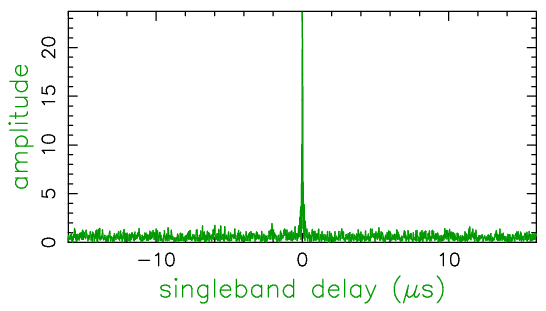
Credit: Credit: Alessandra Bertarini
IGG / Max Planck Institut fur Radioastronomie
2014 May 04 - VLBI interference fringes were also successfully detected
between the 26m telescope at HartRAO and the 70m NASA DSN antenna at
Tidbinbilla, Australia. This
was using the same source as above, and demonstrates the improved
signal-to-noise ratio obtained with the large antenna in Australia.




